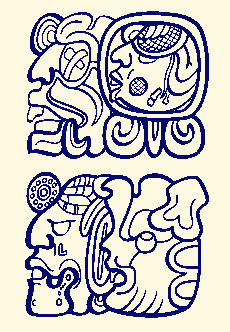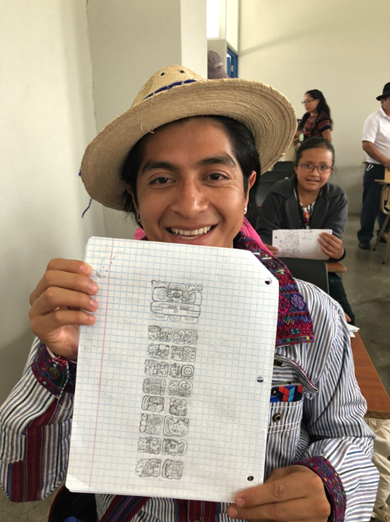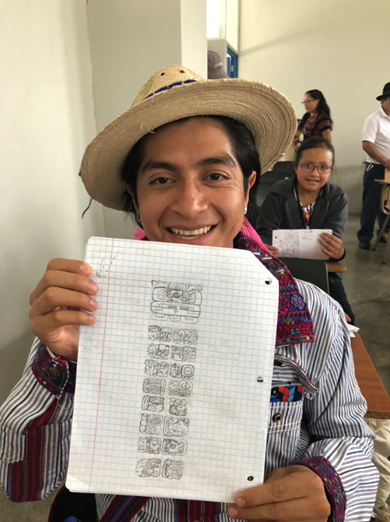
6 Ahaw 13 Sotz’ (June 12, 2022)
Haz clic aquí para leer en español
6 Ahaw 13 Sotz’ (June 12, 2022)
2022 MAM Minigrants Are Now Available!!:
Calling for Applications!
Mam speaker Jun Kanek Nimwitz Pérez at the Fourth International Congreso in 2018.
At long last, we are excited to announce that we are once again starting up our MAM mini-grant program for 2022! It has been over two long years since we have offered funding for face-to-face workshop instruction, and with Covid restrictions now lifting, along with common-sense masking and other precautions, we feel that the time has come for us to help support face-to-face workshops, as well as continuing our support of online instruction and educational videos. For many Maya communities who have been struggling with little access to the internet, we hope this will come as a welcome relief.
Our mission at MAM has consistently been to support Maya instructors who are interested in teaching their students and communities about the ancient Maya writing system and the calendar as a way for them to take pride in their own endangered languages and cultures, as well as in the shared history of the Maya region, which they typically do not learn about in school.
From the very beginning of our work with Maya people, we see our role at MAM as supporting and funding the interests of our Maya colleagues upon invitation, rather than convincing Maya people that they should learn something that may not interest them. However, we have witnessed the profound fascination and interest that many Maya people have taken in learning the ancient script, and how meaningful this has been in their lives and in their work to preserve their languages and cultures. We are happy to provide resources and help to those who seek it, and it is this work that we hope to continue.
It has been far too long since we have been able to provide the full support that our Maya colleagues need. The Fourth Congreso was held four years ago in 2018, and we are hoping that the Fifth Congreso will finally be able to take place next year in 2023. These mini-grants will greatly help in the preparations for this larger event.
There are approximately thirty different languages within the Mayan language family that all descended from a common linguistic ancestral language more than 3,000 years ago, with sub-families of the Mayan family sharing even more recent common ancestry. While each language and culture within the Mayan family has its own unique and complex history, all Maya cultures share similar calendars, stories, and cultural practices, as well as having faced over 500 years of European colonization and discrimination.
Based on the evidence, we now know that the Classic Maya writing system was largely used to write languages within the Ch’olan, Tzeltalan, and Yucatecan sub-families. The now extinct language of Classical Ch’olti’ was the primary scribal language, though such formal scripts like this in history have often been used by educated and elite scribes who spoke multiple different languages and dialects.
While many Mayan languages may not have commonly been written themselves, speakers of many current Mayan languages have now taken great interest in learning about the writing system since it began to be deciphered, and they have even adapted the Classic script to accommodate sounds in these different languages as they are spoken today. This process is very similar to how European speakers of many different languages looked to Classical Greece and Rome during the Renaissance, adapting the Greek and Roman alphabets to write their own languages, while also taking pride in reviving the shared ancient history on their continent and bringing about a rebirth and celebration of ancient culture—creating new and vibrant living traditions.
As has been our practice in the past, we will now once again accept applications and proposals from Maya teachers who have preferably attended previous workshops or Congresos. This coming week, we will send out a call for applications to our current mailing list of Maya colleagues. However, if you are a Maya instructor who is not on our mailing list and you would like to receive an application, please feel free to contact us at
We will be able to fund approximately 30 mini-grants with a typical budget of up to $200 US each. We ask for an itemized budget with the application, and a written report to be submitted to us within one month of the end of the workshop.
We look forward to announcing our first 2022 mini-grant recipients next month!
Chjonte, Sib’alaj Maltiyox, Yum Bo’otik,
Michael Grofe, President
MAM




